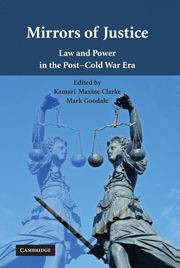Book contents
- Frontmatter
- Contents
- Editor Biographies
- Contributors
- Acknowledgments
- Introduction: Understanding the Multiplicity of Justice
- 1 Beyond Compliance: Toward an Anthropological Understanding of International Justice
- PART I JUSTICE AND THE GEOGRAPHIES OF INTERNATIONAL LAW
- PART II JUSTICE, POWER, AND NARRATIVES OF EVERYDAY LIFE
- PART III JUSTICE, MEMORY, AND THE POLITICS OF HISTORY
- 11 Impunity and Paranoia: Writing Histories of Indonesian Violence
- 12 National Security, Weapons of Mass Destruction, and the Selective Pursuit of Justice at the Tokyo War Crimes Trial, 1946–1948
- 13 Justice and the League of Nations Minority Regime
- 14 Commissioning Truth, Constructing Silences: The Peruvian Truth Commission and the Other Truths of “Terrorists”
- Epilogue: The Words We Use: Justice, Human Rights, and the Sense of Injustice
- Index
- References
14 - Commissioning Truth, Constructing Silences: The Peruvian Truth Commission and the Other Truths of “Terrorists”
Published online by Cambridge University Press: 25 January 2010
- Frontmatter
- Contents
- Editor Biographies
- Contributors
- Acknowledgments
- Introduction: Understanding the Multiplicity of Justice
- 1 Beyond Compliance: Toward an Anthropological Understanding of International Justice
- PART I JUSTICE AND THE GEOGRAPHIES OF INTERNATIONAL LAW
- PART II JUSTICE, POWER, AND NARRATIVES OF EVERYDAY LIFE
- PART III JUSTICE, MEMORY, AND THE POLITICS OF HISTORY
- 11 Impunity and Paranoia: Writing Histories of Indonesian Violence
- 12 National Security, Weapons of Mass Destruction, and the Selective Pursuit of Justice at the Tokyo War Crimes Trial, 1946–1948
- 13 Justice and the League of Nations Minority Regime
- 14 Commissioning Truth, Constructing Silences: The Peruvian Truth Commission and the Other Truths of “Terrorists”
- Epilogue: The Words We Use: Justice, Human Rights, and the Sense of Injustice
- Index
- References
Summary
“There is no reconciliation possible with the assassins of Shining Path.”
– Alan García, Correo, August 14, 2003“With Shining Path there can be no pact, no political solution and no form of reconciliation.”
– Congresswoman and former presidential candidate Lourdes Flores Nano, La República, August 10, 2003“The government never resolved the problems that caused the war. They should solve them! The same motives for waging war are still there. The strategies may change, but the motives are still present. It's not about giving alms to the poor or asking people to give their leftovers to them. The poor are also Peruvians! It's an obligation of the state to watch out for the well being of the population.”
– Shining Path militant, Interview, Chorillos Prison, June 23, 2007INTRODUCTION
On August 28, 2003, the Commissioners of the Peruvian Truth and Reconciliation Commission (PTRC) submitted their Final Report to President Alejandro Toledo and the nation. After two years of work and some 17,000 testimonies, the Commissioners had completed their task of examining the causes and consequences of the twenty-year internal armed conflict (1980–2000) between the Peruvian armed forces and two armed rebel groups, Sendero Luminoso (SL) and the Movimiento Revolucionario Túpac Amaru (MRTA). Peru thus joined the growing list of countries that have implemented truth commissions as a means of transitioning from a period of armed conflict and authoritarian rule toward the founding of a procedural democracy and the rule of law.
- Type
- Chapter
- Information
- Mirrors of JusticeLaw and Power in the Post-Cold War Era, pp. 291 - 315Publisher: Cambridge University PressPrint publication year: 2009
References
- 3
- Cited by



